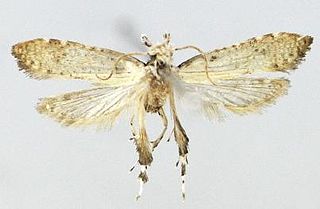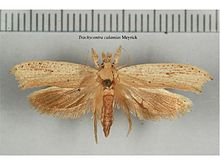
Cydia is a large genus of tortrix moths, belonging to the tribe Grapholitini of subfamily Olethreutinae. Its distinctness from and delimitation versus the tribe's type genus Grapholita requires further study.

Pandemis is a genus of moths of the family Tortricidae and the tribe Archipini.
Comodica is a small genus of the fungus moth family, Tineidae. Therein, it belongs to the subfamily Erechthiinae. It is apparently a close relative of the type genus of its subfamily, Erechthias.

Erechthias is a genus of the fungus moth family, Tineidae. Therein, it belongs to the subfamily Erechthiinae, of which it is the type genus. The exact circumscription of this genus is still disputed, but it may encompass more than 150 species.

Oinophila is a small genus of the fungus moth family, Tineidae. Therein, it belongs to the subfamily Hieroxestinae.

Opogona is a genus of the fungus moth family, Tineidae. Therein, it belongs to the subfamily Hieroxestinae. As it includes Opogona omoscopa, the type species of the now-abolished genus Hieroxestis, it is the type genus of its subfamily.
Wegneria is a genus of moths belonging to the family Tineidae.

Infurcitinea is a genus of the fungus moth family, Tineidae. Therein, it belongs to the Meessiinae, one of the larger fungus moth subfamilies.

Moerarchis is a genus of moths belonging to the family Tineidae.

Ateliotum is a small genus of the fungus moth family, Tineidae. It belongs to the subfamily Myrmecozelinae.

Gerontha is a genus of moths belonging to the family Tineidae.

Haplotinea is a very small genus of fungus moths. Its subfamily among the fungus moths is disputed – many assign it to the Myrmecozelinae, but other authors have placed it in subfamily Nemapogoninae or Perissomasticinae. In all, its relationships are barely better resolved at present than those of the many Tineidae incertae sedis.

Edosa is a genus of moths belonging to the family Tineidae.
Ceratobia is a small genus of the fungus moth family, Tineidae. Therein, it belongs to the subfamily Tineinae.
Catalectis is a small genus of the fungus moth family, Tineidae. It is a small and little-studied group, whose precise relationships remain to be discovered. C. pharetropa was once mistaken for a species of Clepticodes, and Oenoe drosoptila of the Meessiinae was also proposed as a species of Catalectis; ít may be that these are all, in fact, closely related.

Sorolopha is a genus of moths belonging to the subfamily Olethreutinae of the family Tortricidae.

Tinea is a genus of the fungus moth family, Tineidae. Therein, it belongs to the subfamily Tineinae. As evident by its name, it is the type genus of its subfamily and family. Established as one of the first subgroups of "Phalaena", it used to contain many species of Tineidae that are nowadays placed in other genera, as well as a few moths nowadays placed elsewhere.

Tinissa is a genus of the fungus moth family (Tineidae). Therein, it belongs to the subfamily Scardiinae.

Trachycentra calamias is a moth of the family Tineidae described by Edward Meyrick in 1886. It is found on the Cook Islands, Fiji, French Polynesia and Tonga.















